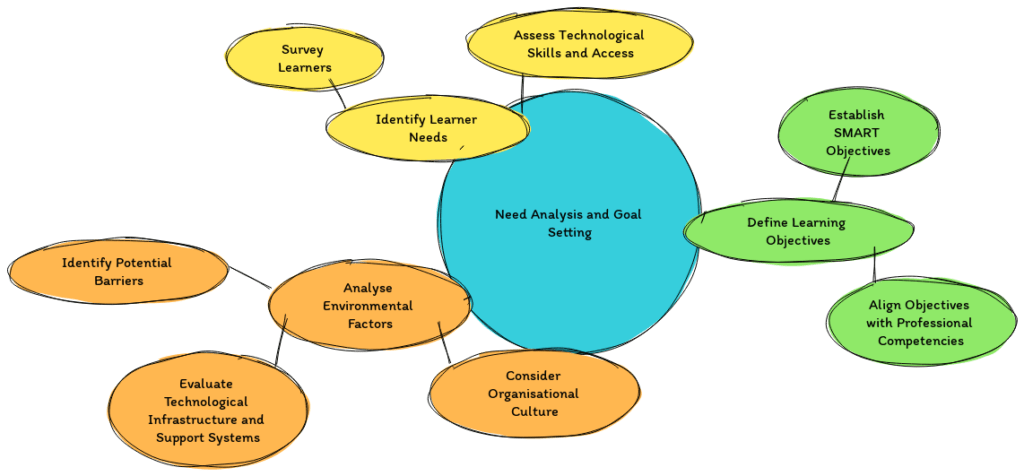Blended learning has revolutionised the educational landscape by combining the best of traditional face-to-face instruction with e-learning methods. This hybrid approach uses the strengths of each to create more engaging, flexible, and effective learning experiences. The design of effective blended learning programmes involves careful planning, a deep understanding of learners’ needs, and strategic integration of various instructional components. This article will explore key considerations and best practices for designing blended learning programmes that maximise the potential of both in-person and online environments.
Needs Analysis and Goal Setting
Before designing a blended learning programme, conducting a thorough needs analysis and establishing clear learning goals is essential. This initial step ensures that the programme meets the specific needs of the learners and aligns with organisational objectives. Here’s a detailed breakdown of this process:

Identify Learners’ Needs
- Survey Learners:
- Preferences: Conduct surveys, interviews, or focus groups to gather information on learners’ preferences for content delivery methods (e.g., face-to-face, online, self-paced).
- Challenges: Identify challenges learners face, such as balancing work and study, language barriers, or specific content areas they find difficult.
- Prior Knowledge: Assess learners’ existing knowledge and skills to tailor the programme content appropriately and avoid redundancy.
- Assess Technological Skills and Access:
- Technological Proficiency: Evaluate the learners’ comfort and proficiency with technology. This includes their ability to use computers, navigate the internet, and utilise specific software or online platforms.
- Access: Determine whether learners have reliable access to the necessary technology and internet connectivity. This ensures that all participants can engage with the online components of the blended learning programme.
Define Learning Objectives
- Establish SMART Objectives:
- Specific: Clearly define what the learners can do after completing the programme.
- Measurable: Ensure that the objectives can be assessed through tests, assignments, or other evaluation methods.
- Achievable: Set realistic objectives that are attainable given the learners’ starting point and the programme duration.
- Relevant: Align the objectives with the learners’ roles and responsibilities within the organisation.
- Time-bound: Specify the timeframe within which the learners should achieve the objectives.
- Align Objectives with Professional Competencies:
- Professional Competencies: Identify the competencies required for the learners’ job roles and ensure the learning objectives support the development of these competencies.
- Job Performance Requirements: Link the learning objectives to specific job performance criteria, ensuring the programme enhances the learners’ effectiveness in their roles.
Analyse Environmental Factors
- Consider Organisational Culture:
- Culture: Understand the organisational culture, including attitudes towards learning and development, to design a programme that fits well within this context.
- Support: Identify the level of support from management and colleagues for participating in the programme.
- Evaluate Technological Infrastructure and Support Systems:
- Infrastructure: Assess the existing technological infrastructure, such as the availability of computers, software, and internet access, to ensure it can support the blended learning programme.
- Support Systems: Determine the availability of technical support for learners and instructors, including help desks or IT support teams.
- Identify Potential Barriers:
- Time Constraints: Recognise any time constraints that might affect learners’ ability to participate in the programme, such as work schedules or personal commitments.
- Learning Environment Distractions: Consider potential distractions in the learning environment, whether online or face-to-face, and find ways to minimise these to maximise learning effectiveness.
By meticulously addressing these components, you can design a blended learning programme well-suited to your learners’ needs and aligns with your organisational goals, ultimately leading to more effective and meaningful learning experiences.
Integration of Learning Activities
The effectiveness of a blended learning programme depends on the seamless integration of various learning activities that complement each other and reinforce learning outcomes. A well-designed blend incorporates synchronous and asynchronous elements to cater to diverse learning styles and schedules. Synchronous learning includes real-time virtual classrooms through video conferencing tools, allowing interactive sessions, live discussions and Q&A sessions that replicate the engagement of traditional classrooms. Asynchronous learning involves self-paced e-learning modules, including interactive multimedia content, discussion forums and social learning platforms for ongoing peer interaction and collaboration. Face-to-face interactions feature in-person workshops for hands-on practice and application of skills, alongside networking opportunities and community-building activities.
Choosing the right technology is key to designing a blended learning programme. The selected tools must enhance the learning experience, be user-friendly, and support achieving learning objectives. Learning Management Systems (LMS) serve as centralised platforms for managing and delivering online courses and tracking learner progress, with features to look for, including mobile compatibility, user analytics, and content integration. Content creation tools are essential for developing multimedia learning resources, such as videos, simulations, and interactive assessments, with software that supports diverse content formats (e.g., SCORM, xAPI) for seamless integration with the LMS. Communication tools are also necessary, providing platforms for encouraging collaboration, such as discussion boards, chat applications, group project tools, and scheduling and calendar tools for coordinating synchronous sessions and deadlines.
Monitoring and Evaluation
Continuous monitoring and evaluation are essential to ensure a blended learning programme’s effectiveness and ongoing improvement. Employing various assessment methods provides comprehensive insights into learner progress and the programme’s overall impact, allowing educators to make data-driven adjustments that enhance learning outcomes.
Formative Assessments: Regular formative assessments are key for tracking learners’ understanding throughout the course. These can include quizzes and short tests administered periodically to gauge comprehension and provide immediate feedback. Such assessments help identify areas where learners may be struggling, enabling timely intervention and support. Additionally, incorporating peer reviews and self-assessments encourages reflective learning, where learners critique their and others’ work, promoting a deeper understanding of the subject matter and critical thinking skills.
Summative Assessments: Summative assessments are paramount for evaluating overall learning outcomes at the end of the course. These assessments can be final exams, comprehensive projects, or presentations that require learners to apply their knowledge and skills in practical, often real-world scenarios. Aligning these assessments with the initial learning objectives ensures that the programme effectively meets its goals and allows educators to measure success rates accurately. This alignment also helps identify gaps between the intended and achieved learning outcomes, informing future curriculum adjustments.
Feedback Mechanisms: Collecting feedback from learners is an integral part of the evaluation process. Post-course surveys and interviews provide valuable insights into the programme’s strengths and areas for improvement. Learners’ perspectives on the content, delivery methods, and overall learning experience can highlight aspects that might not be evident through assessments alone. Additionally, using the Learning Management System (LMS) analytics allows educators to track various metrics, such as participation rates, engagement levels, and performance trends. These data points can reveal patterns that inform decisions about curriculum adjustments, support needs, and potential enhancements to the learning environment.
Educators can ensure that a blended learning programme remains dynamic and responsive to learners’ needs by integrating continuous monitoring and evaluation into the programme design. This approach not only enhances the quality of education but also supports the achievement of learning objectives, contributing to the overall success and sustainability of the programme.
Conclusion
Designing effective blended learning programmes requires a strategic approach integrating diverse learning activities, suitable technologies, and robust evaluation methods. By meticulously planning and continuously refining these programmes, educators and organisations can offer rich, flexible learning experiences that cater to the needs of modern learners. The blend of face-to-face and online elements creates a dynamic learning environment that enhances knowledge retention and encourages skill development and learner engagement. As technology continues to evolve, so will the possibilities for blended learning, making it an ever-more valuable approach to education and professional development.



